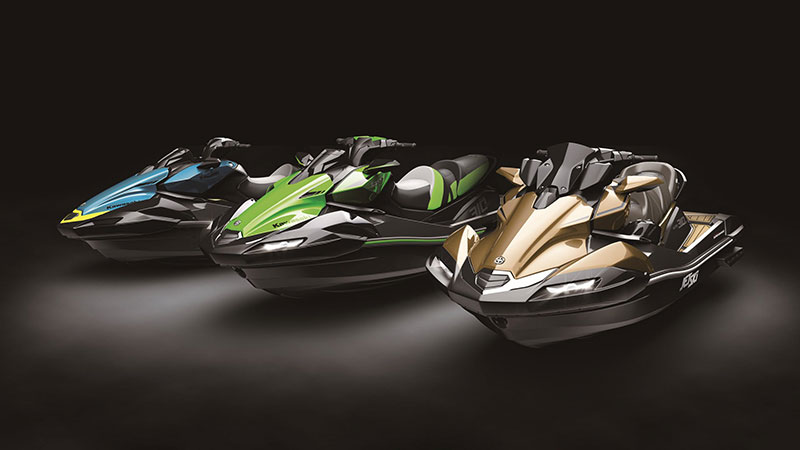After a decade in the Jet Ski wilderness – with industry insiders at times questioning Kawasaki’s future in the sport – the company has reaffirmed its commitment and made up for lost ground by investing heavily in the biggest change to its supercharged flagship in 14 years.
The 2022 Kawasaki Ultra 310 range – the pinnacle of the Kawasaki Jet Ski line-up – was unveiled in the US overnight ahead of the production ramp-up later this year and showroom arrivals next year.
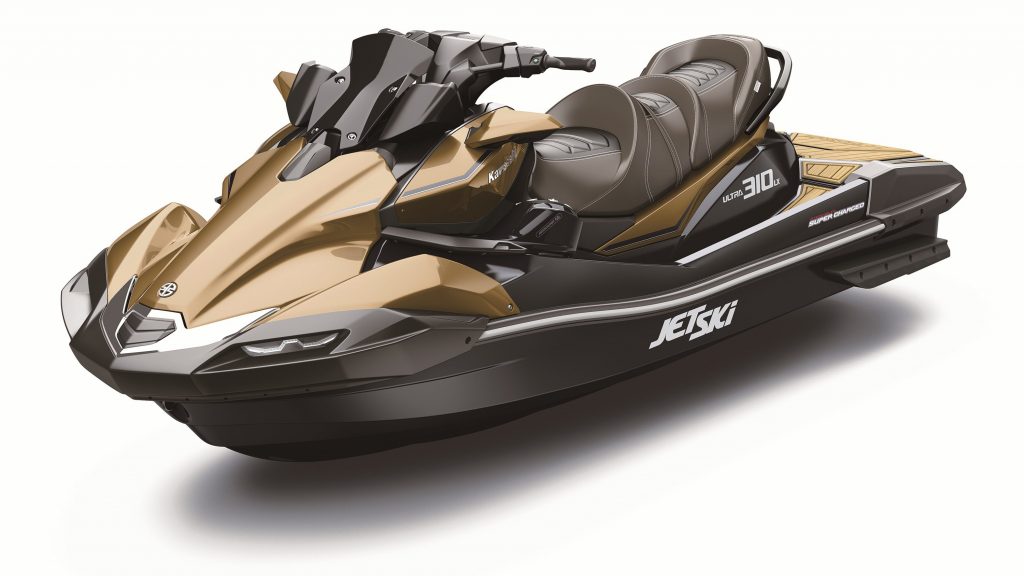
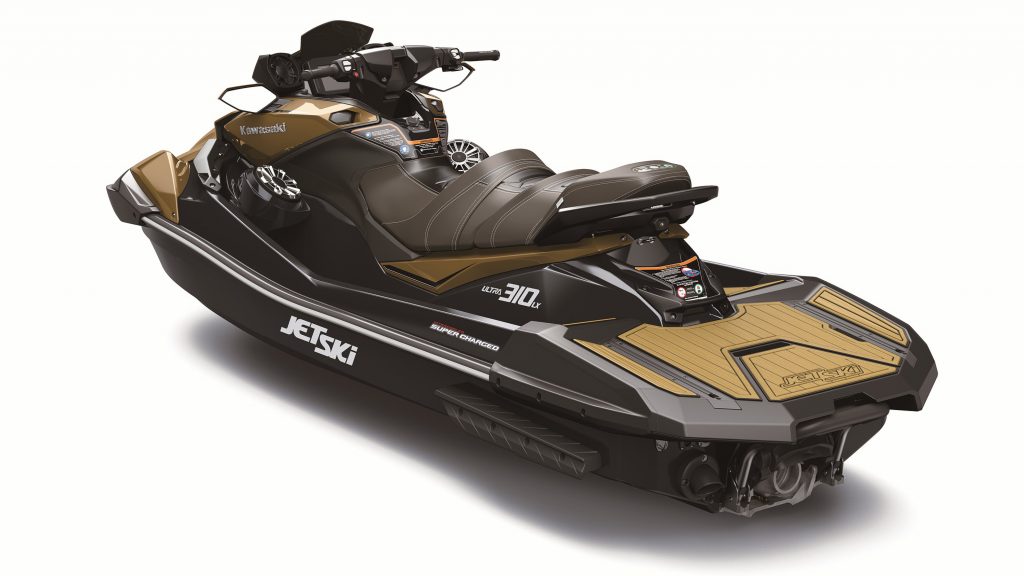
The changes go way beyond the futuristic “Formula One styling” (as described by The Watercraft Journal’s editor-in-chief Kevin Shaw), industry-first LED daytime running lights, and the rear-view camera on top-end models.
The 2022 Kawasaki Ultra 310 range signals the biggest makeover in Kawasaki’s supercharged Jet Ski history, and promises a bright future as the technology eventually trickles down to more affordable models in the years ahead.
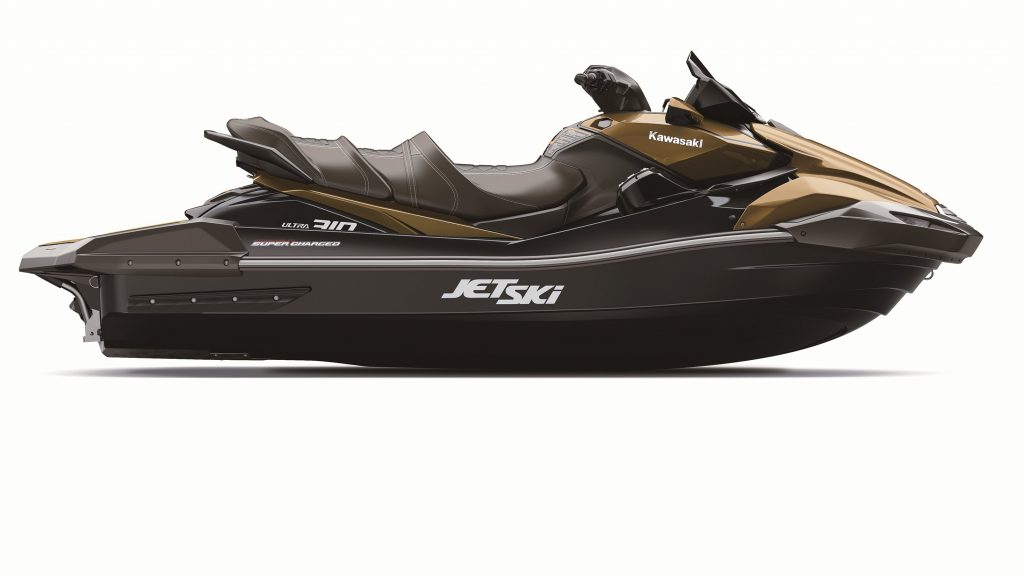
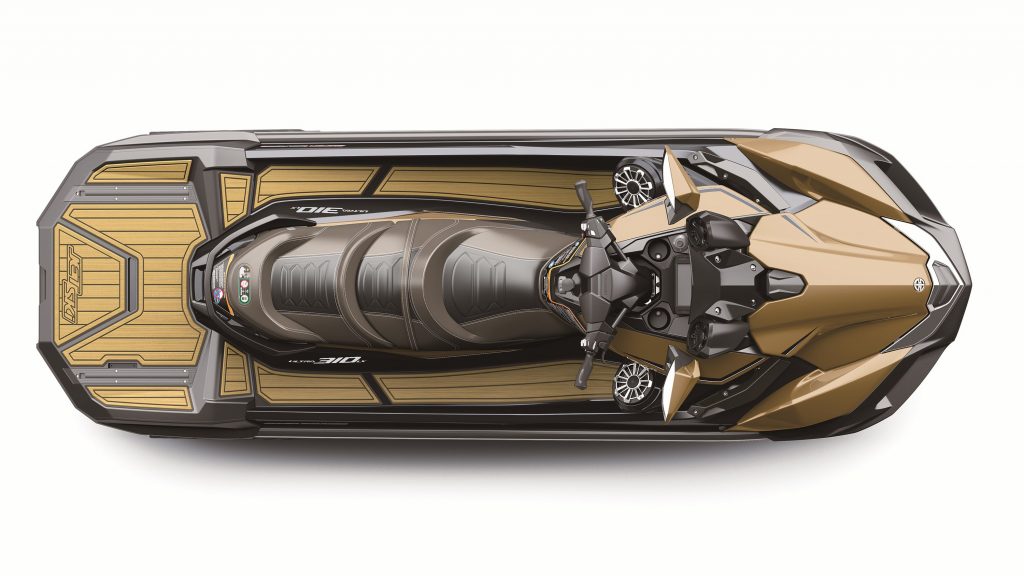
There are three models in the 2022 supercharged line-up, including a new middle-of-the-range option that replaces the race-inspired Kawasaki Ultra 310R, as the brand broadens its appeal among the booming recreation Jet Ski market.
The Kawasaki Ultra 310X (turquoise and black) is the entry point in the supercharged line-up, a newly-named Kawasaki Ultra 310LX-S (green and black) is the mid-grade model, and the Kawasaki Ultra 310LX (gold and black) is the flagship of the fleet.
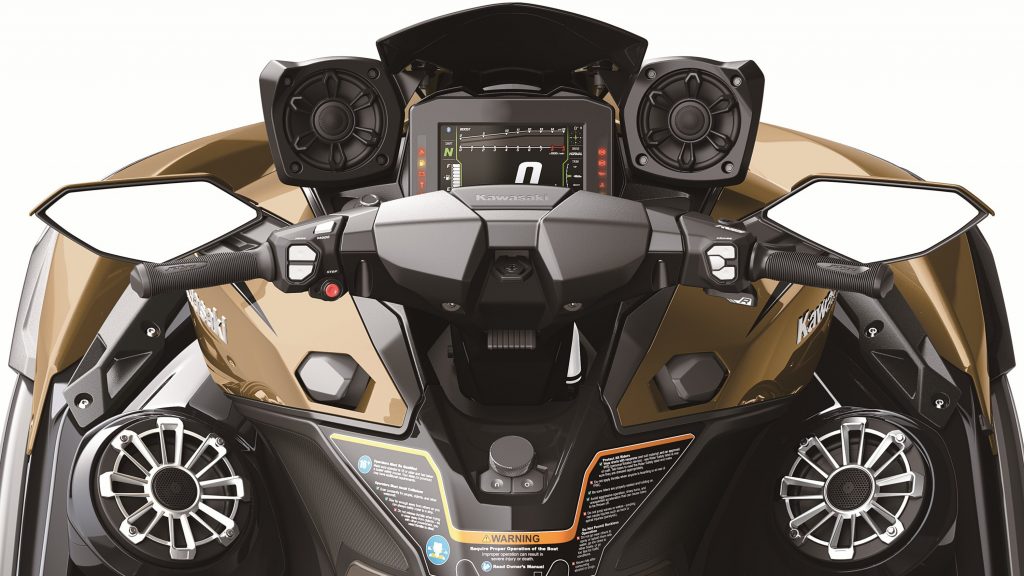
With the significant changes come price hikes that follow similar increases for the 2022 Sea-Doo and Yamaha models.
Prices in the US excluding taxes, registration, and a trailer are as follows: Kawasaki Ultra 310X ($US17,199), Kawasaki Ultra 310LX-S ($US18,199) and Kawasaki Ultra 310LX ($US19,199).
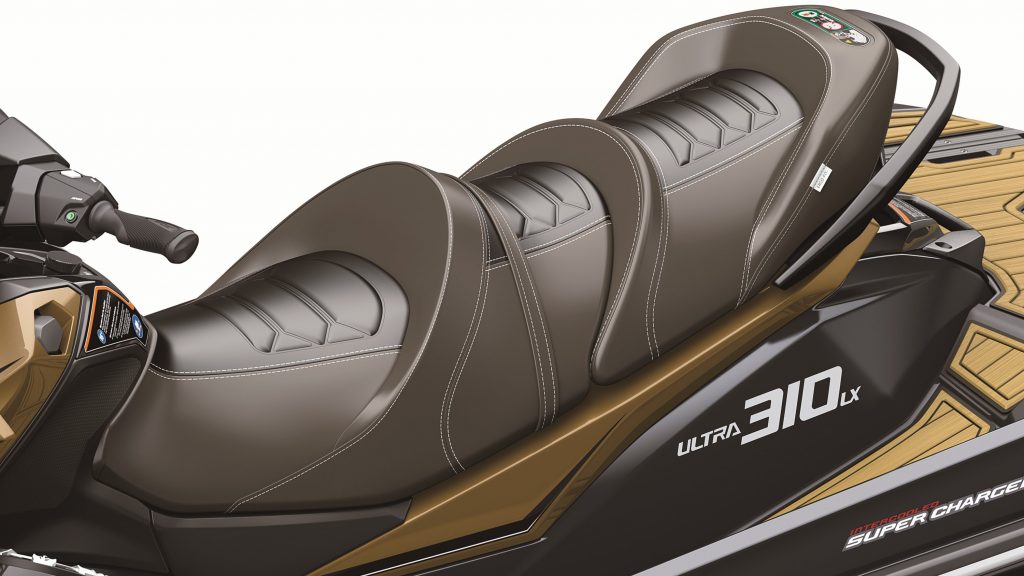
These price points position the 2022 Kawasaki Ultra 310 range alongside rivals such as the Sea-Doo GTX Limited 300, Sea-Doo RXT-X300, and Yamaha FX SVHO WaveRunners.
Australian prices are not due to be announced until closer to local showroom arrivals, however based on current exchange rates and local taxes, the 2022 Kawasaki Ultra 310 range is estimated to be priced between $25,000 and $30,000 not including trailer and registration.
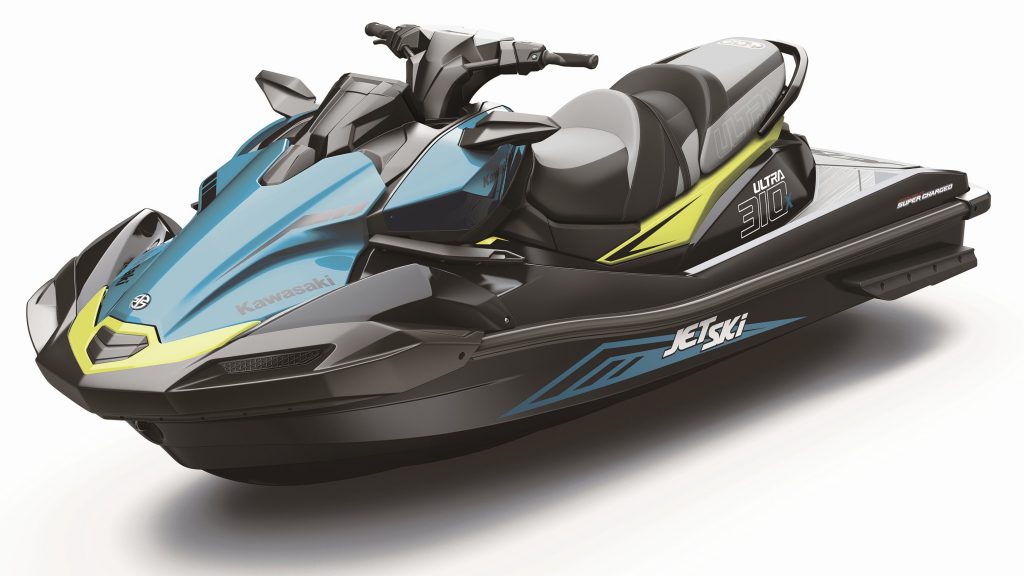
As with the Australian arrival of 2022 models from Sea-Doo and Yamaha, local Kawasaki dealers are bracing themselves – and warning customers – to expect delays.
Watercraft Zone has been given an Australian showroom arrival estimate for the 2022 Kawasaki Ultra 310 Jet Ski range of February 2022 at the earliest.
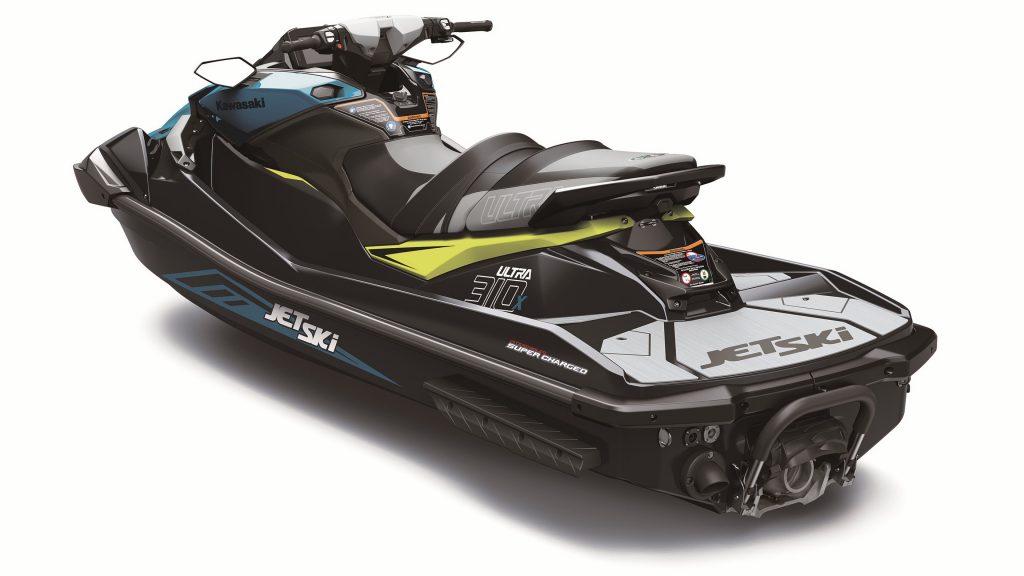
Some dealers fear they may not receive the bulk of their 2022 stock until after the peak of the Australian summer, and in the lead-up to winter.
Kawasaki dealers in Australia say they have already taken orders for the 2022 Kawasaki Ultra 310 range – sight unseen and for prices unknown – and the first customers in the queue will likely be first to take delivery as limited stock becomes available.
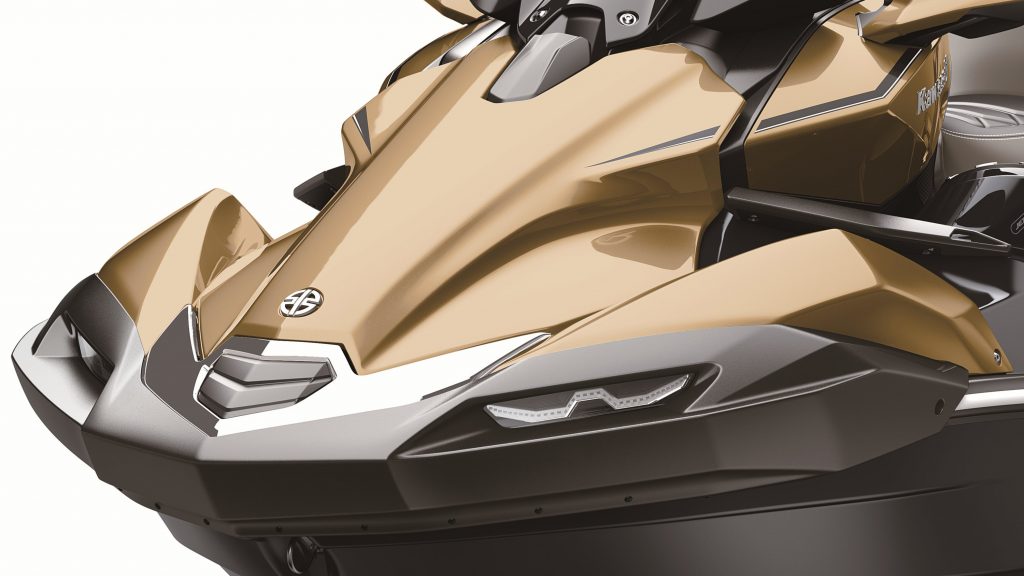
While the delay is not ideal, it will be worth the wait.
Before we launch into the details, here are just some of the highlights:
- First completely new top deck in 14 years
- Rear deck extension for top two LX models
- Rear deck accessories similar to Sea-Doo and Yamaha FX
- Side fairings are now storage pods (in addition to bow storage)
- Height-adjustable seats on flagship 310 LX
- Four-speaker audio on flagship 310 LX
- Rear-view camera on flagship 310 LX
- LED daytime running lights on flagship 310 LX
- 7-inch digital display screen
- Smartphone connectivity
- Infotainment controller dial
- USB charge ports and storage pocket on certain models
- GPS speedometer for the first time
- Trip computer, compass, water temp, ambient temp
- Launch control with auto trim adjustment
- Reverse trigger
- Four performance modes
- 3D raised Kawasaki badging
- Kawasaki Racing badge on the nose
- Stern wet storage pocket
- Tow hook under rear seat
- Dock tiedown points on the handlebars
- 1.89 litres extra fuel capacity (to 79.89 litres)
For now, the above changes apply only to the 2022 Kawasaki Ultra 310 supercharged Jet Ski range.
The non-supercharged 2022 Kawasaki Ultra LX (powered by a naturally aspirated 1.5-litre four-cylinder) continues with the same top deck design introduced in 2007; it’s expected this model will get the new top deck and associated technology in 2023 or later.
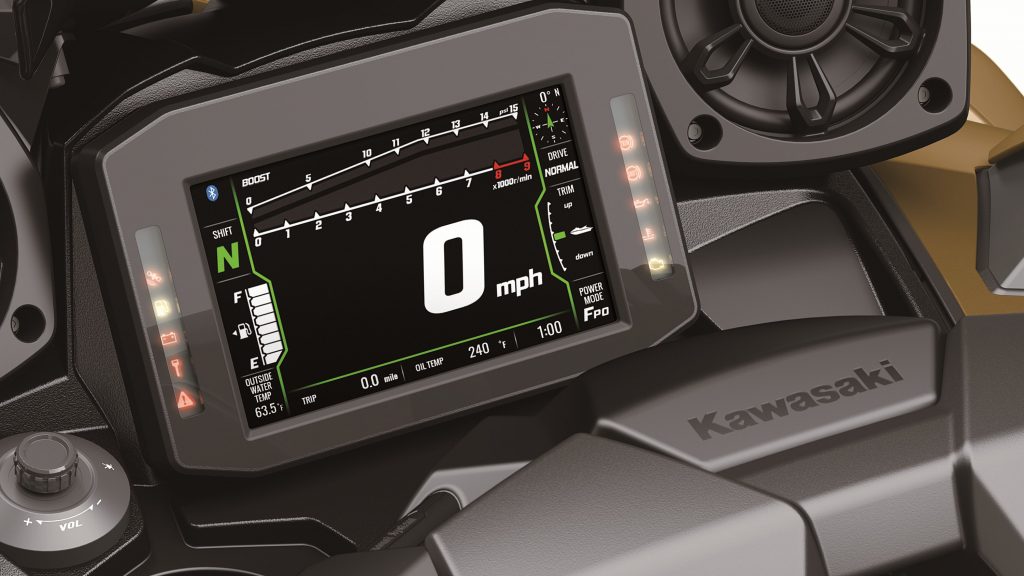
In the meantime, the 2022 Kawasaki Ultra 310 Jet Ski range will forge the path ahead for Kawasaki, as it aims to recover from its modest 6.5 per cent share of the personal watercraft market in Australia (versus 67.5 per cent market share for Sea-Doo and 26 per cent market share for Yamaha).
Headlining the numerous changes, Kawasaki will join top-end Sea-Doo and Yamaha models with a large digital screen with smartphone connectivity to take or make calls, receive messages, monitor Jet Ski vitals, and display map instructions.
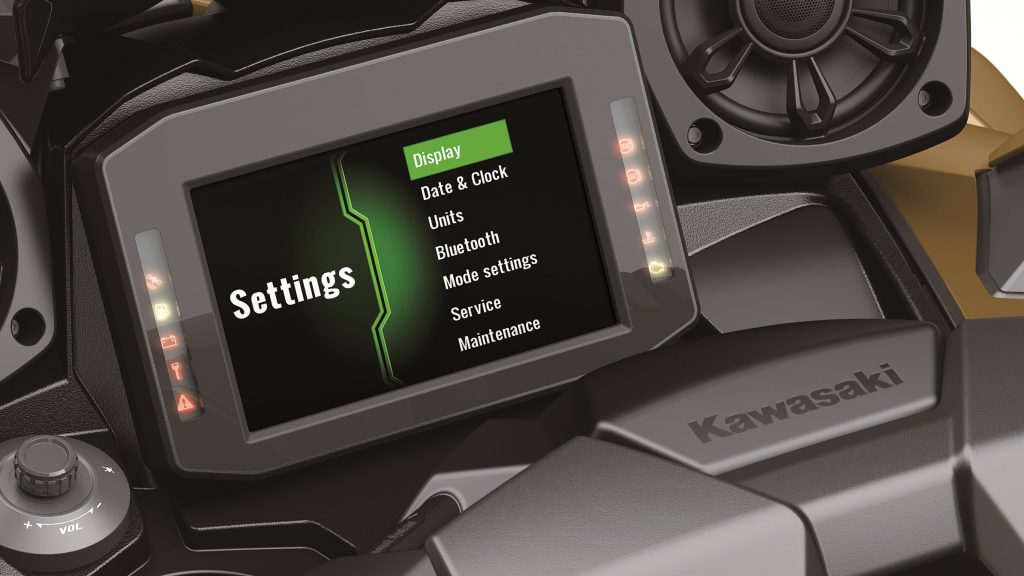
All models in the 2022 Kawasaki Ultra 310 range have a 7-inch digital display screen which, helpfully, come with the convenience of a dial on the console as well as buttons, an industry first.
By comparison, the 2022 Yamaha FX series is available with 5-inch or 7-inch digital display screens controlled by touch or toggle switches, and flagship Sea-Doo models have a 7.8-inch twin-screen operated by toggle switches only.
The Kawasaki screen has three different display modes (digital speedometer, analogue tachometer, and Jet Ski vitals), and the background can be set to either black or white.
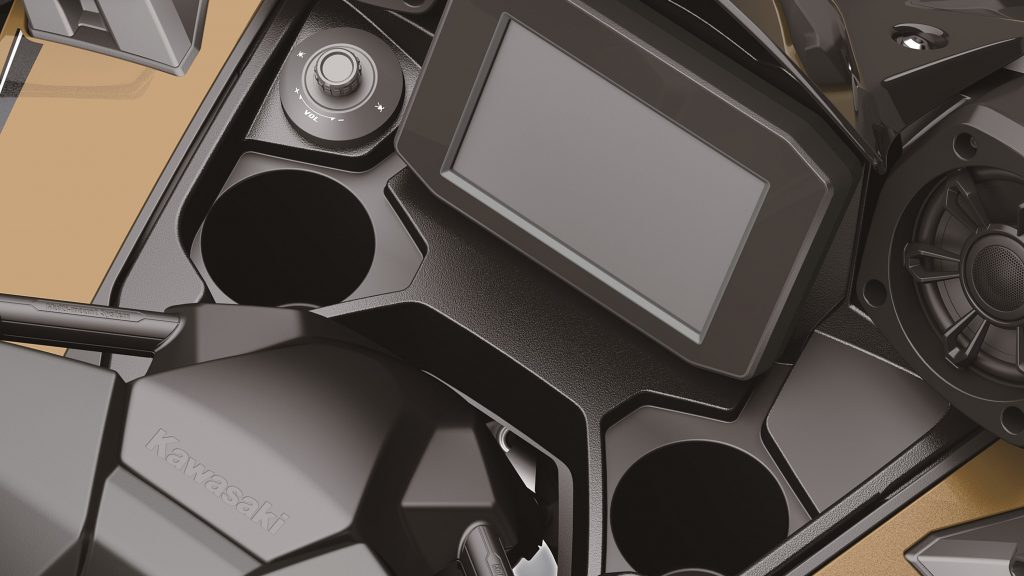
Screen brightness adjusts automatically, but can also be adjusted manually.
The screen can be used to follow GPS waypoints preset via a smartphone, as well the displaying the Jet Ski’s vital signs.
Rider information includes a GPS-based speedometer (replacing the old speedo wheel, and bringing Kawasaki into line with the GPS speedos used on top-end Sea-Doos and the 2022 Yamaha FX range).
In addition there are digital displays for the tachometer, fuel gauge, drive modes, boost pressure, oil temperature, engine coolant temperature, battery voltage, intake air temperature, external air temperature, external water temperature, and diagnostic fault codes.
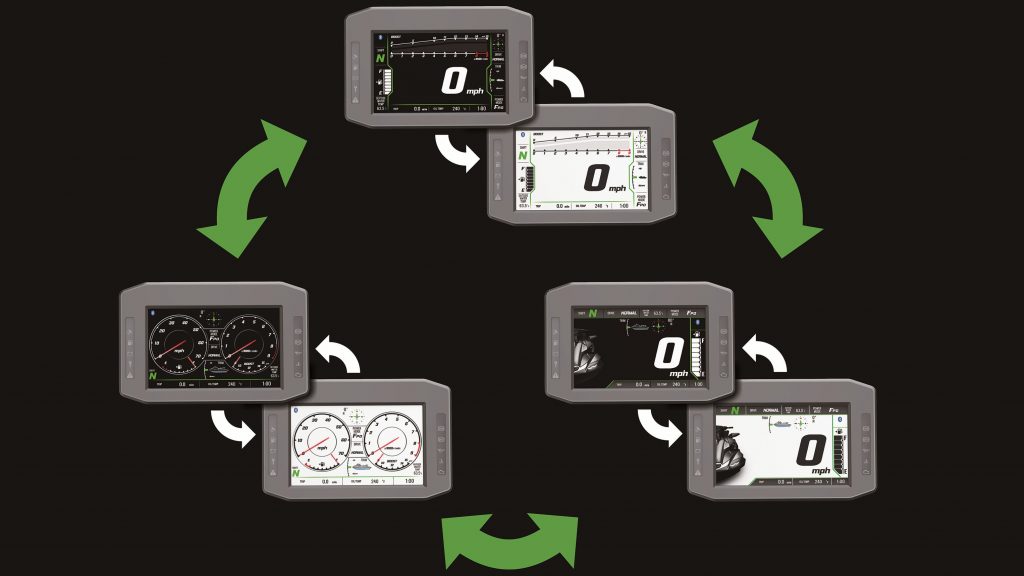
The screen also displays a digital clock, power mode, trim settings, and a compass. A trip meter setting keeps count of total riding time.
For those who need to stay connected, there’s a Bluetooth indicator, a phone call indicator, as well as message alerts.
On the flagship 2022 Kawasaki Ultra 310 LX, the screen can be configured to show a rearview camera image (for tow sports), and you can use it to skip tracks on the audio system.
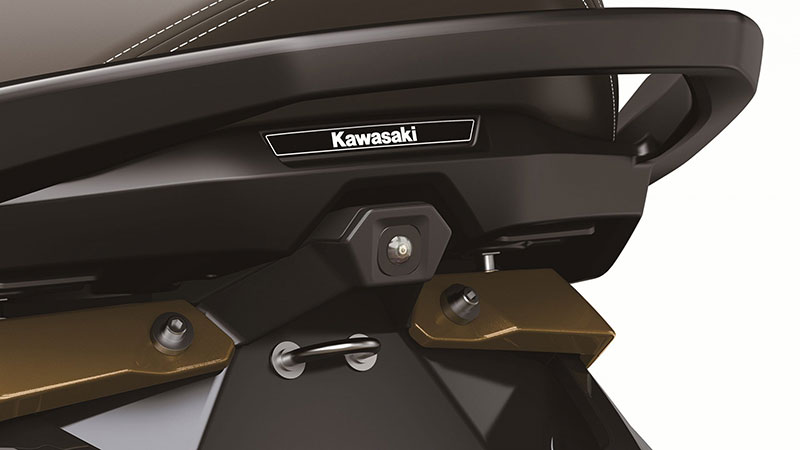
It’s worth noting, in Australia at least, it’s unlikely the rear camera will eliminate the legal requirement to have a rear-facing observer when towing people riding on an inflatable – even with a broad 155° horizontal view and 115° vertical view.
The same goes for the Kawasaki’s industry-first LED lighting. White forward-facing lights are prohibited in some jurisdictions in Australia; it’s possible these could be replaced with blanking plates for examples delivered locally.
While the 2022 Yamaha FX series is available with a two-speaker 50-watt audio system, and the top-end Sea-Doo models are available with a two-seater 100-watt audio system, Kawasaki’s flagship has an industry-first four speaker system (two 60-watt speakers in the front footwells, and two 35-watt speakers on the top console) powered by a 200-watt amp.
The previous Kawasaki Ultra 310LX had two 20-watt speakers.
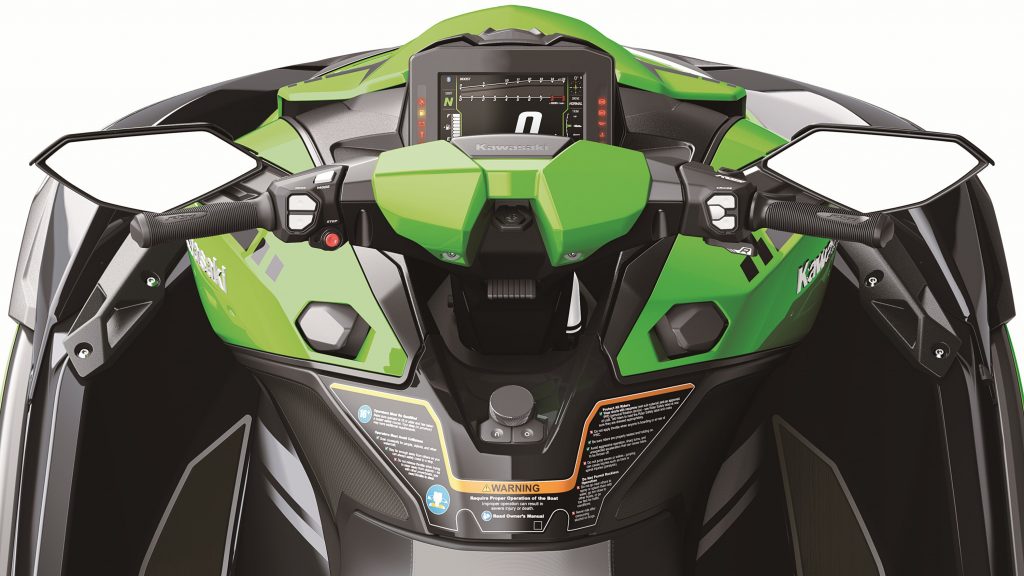
Another industry first, the audio system can be controlled by a volume dial, for faster operation, rather than buttons.
For those worried about fuel consumption, there are four performance modes (full, middle, low and slow). As well as the option of a “learner” slow key, and an eco mode so you can track fuel consumption in real time.
Fuel capacity has reportedly increased by half a gallon (or about 1.89 litres) to a total of 79.89 litres, rather than 78 litres previously. This increase is believed to have come from a longer fuel filler neck rather than a larger tank.
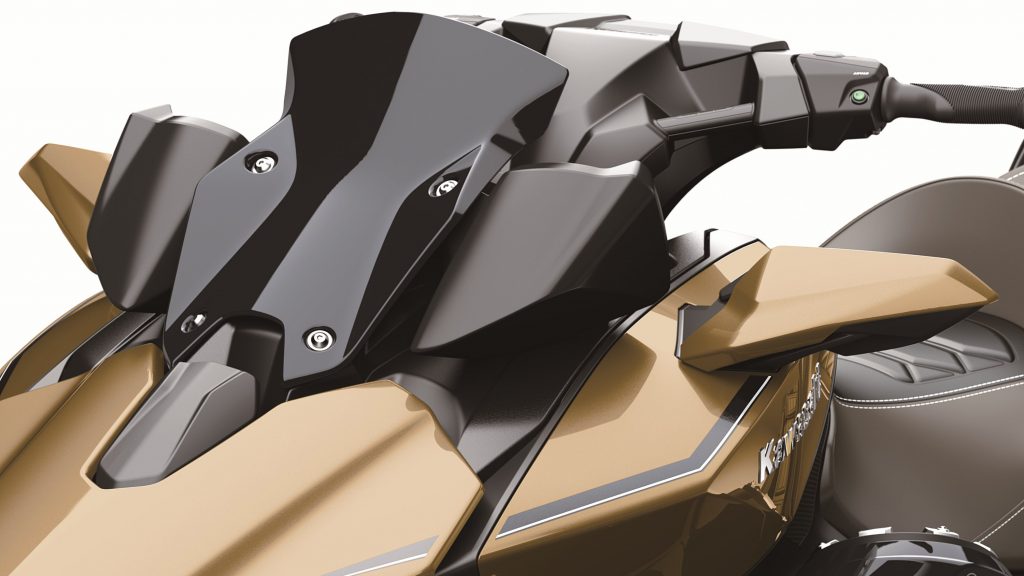
While the 2022 Kawasaki Ultra 310 series has less storage space than before (down from a total of 212 litres to 168.5 litres, a 20 per cent reduction) it still has among the most cargo space in the business (the 2022 Yamaha FX has 167 litres of cargo space and the 2022 Sea-Doo RXT-X300 has 98.9 litres of cargo space).
Furthermore, the Kawasaki’s storage compartments are now more practical. Although there is no longer a glovebox directly in front of the rider, the side fairings open up to create 20 litres of storage space each side.
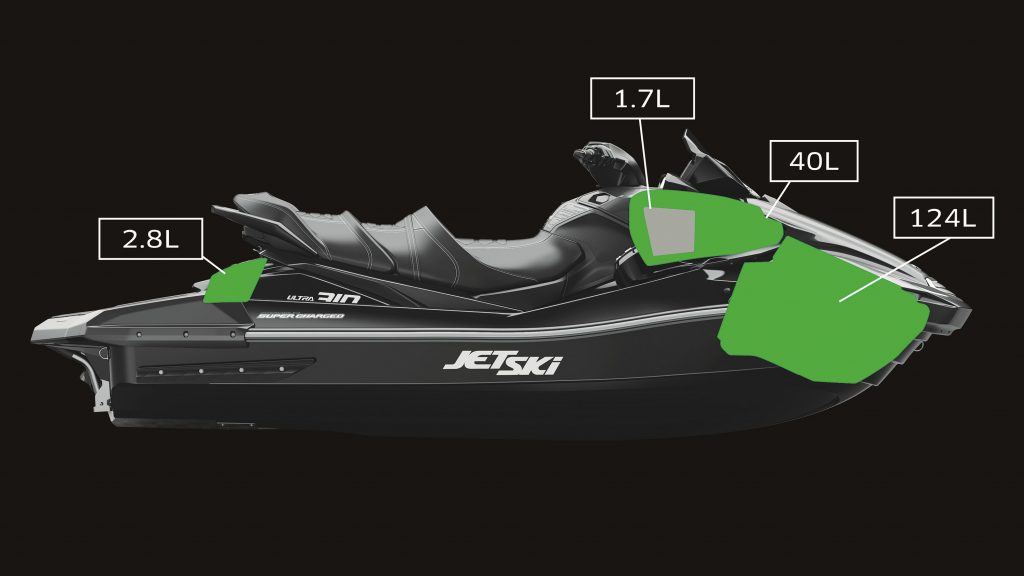
Plus there is a waterproof 1.7-litre pocket hidden within the right-hand-side pod which, on certain models, has two USB charging ports.
The 2022 Kawasaki Ultra 310 range also has a small wet storage area on the stern (2.8 litres in capacity versus 2.3 litres of stern storage on the Kawasaki STX160 stablemate, and 11 litres on the rear of the Yamaha FX).
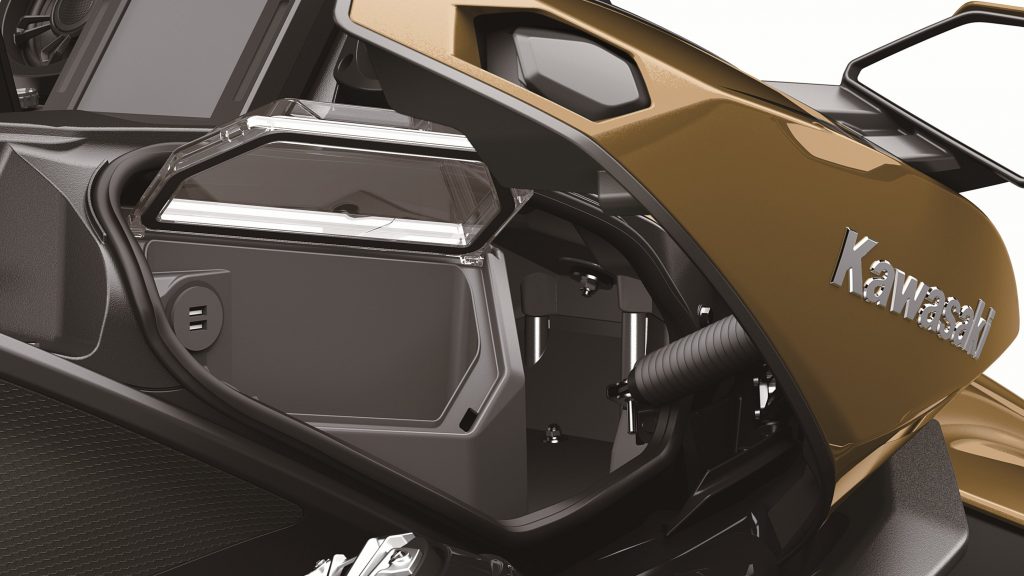
Other convenient touches: the handlebars have extra posts to rope the craft to a dock.
While the top deck is completely new from the bond line up, there are two types of top deck.
The 2022 Kawasaki Ultra 310X has a standard length deck, while the 2022 Kawasaki Ultra 310LX-S and 2022 Kawasaki Ultra 310LX have a rear deck extension that adds 7.9-inches or an extra 20cm.
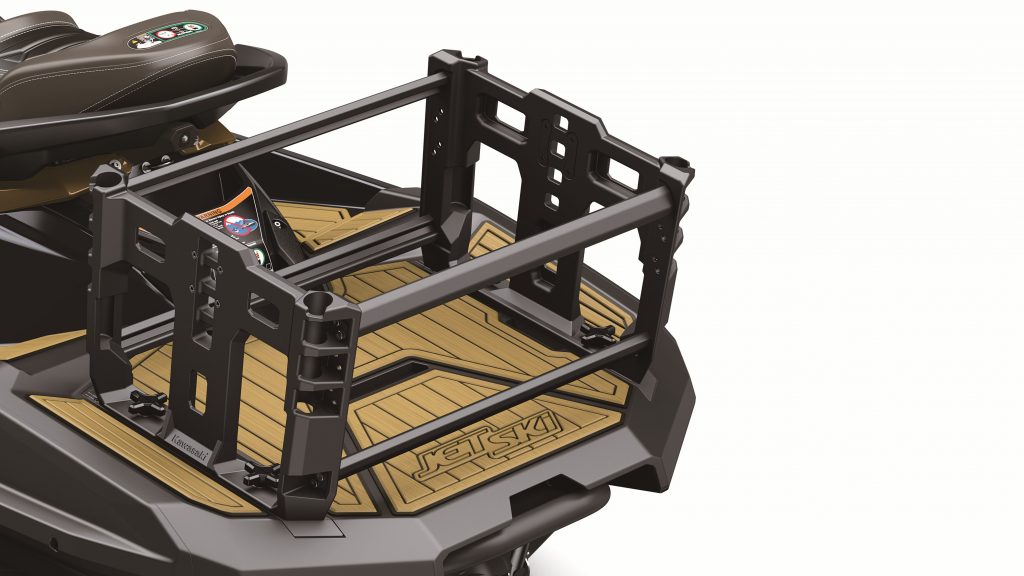
This extra space – plus two channels (one on either side) – accomodate a range of new Kawasaki accessory attachments designed to rival the Sea-Doo Fish Pro and its Linq accessory system, and the new “RecDeck” options for the 2022 Yamaha FX WaveRunner range.
For now, Kawasaki has unveiled accessories such as a frame to carry a cooler box, and a soft bag that fits neatly on the stern. However, this is believed to be the start of a broader range of add-on accessories.
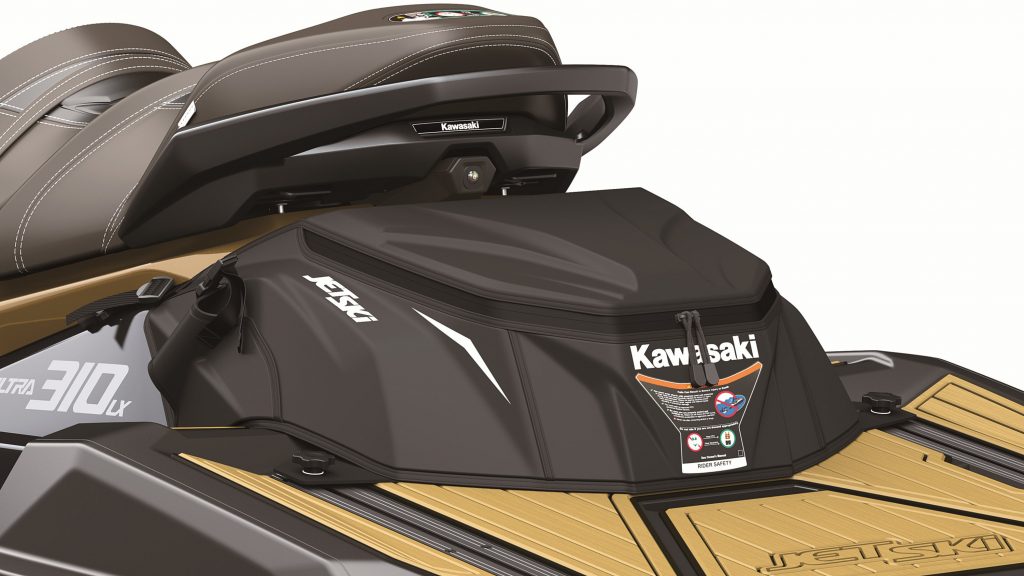
From the bond line down, there are only a few subtle changes to the 2022 Kawasaki Ultra 310 compared to when this hull debuted in 2007. As the saying goes, if it aint broke, don’t fix it.
The sponsons – and the design, shape, and construction of the heavy-duty SMC fibreglass hull – remain unchanged.
The intake grate and the underside shape of the ride plate are believed to be the same as before.
But the ride plate appears to have new upper attachment points to accomodate the redesigned bucket, now activated via a reverse trigger.
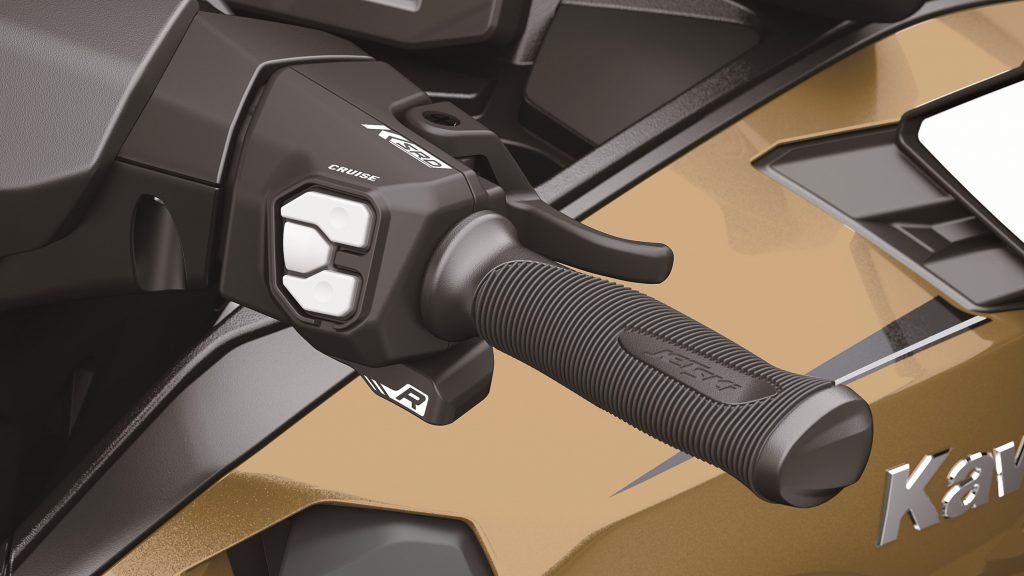
While Sea-Doo and Yamaha have reverse triggers on the left handlebar and an accelerator on the right handlebar, the 2022 Kawasaki Ultra 310 models instead have two triggers on the right handlebar.
While the accelerator trigger action is the same as the Sea-Doo and Yamaha (and previous Kawasaki models) reverse is activated via a small trigger for the right thumb.
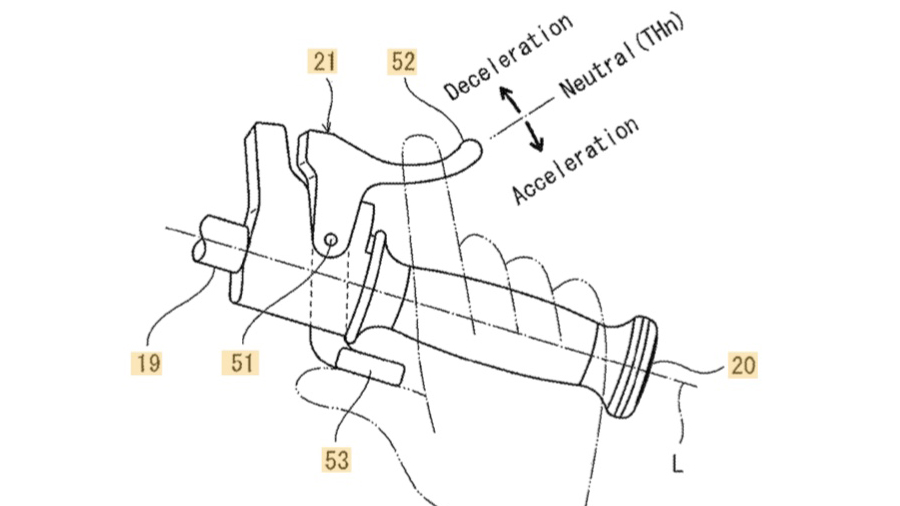
While the 2022 Kawasaki Ultra 310 Jet Ski range retains the roots-type Eaton Twin Vortices Series (TVS) supercharger paired to the familiar 1.5-litre four-cylinder engine – with the same 310-horsepower output as before – and has the same 160mm jet pump nozzle, it promises better performance thanks to the new top deck’s lower centre of gravity, and the option of launch control for the first time.
Once launch control is activated, the Kawasaki automatically adjusts the trim (as per Yamaha and Sea-Doo launch control systems) to provide the optimum standing start.
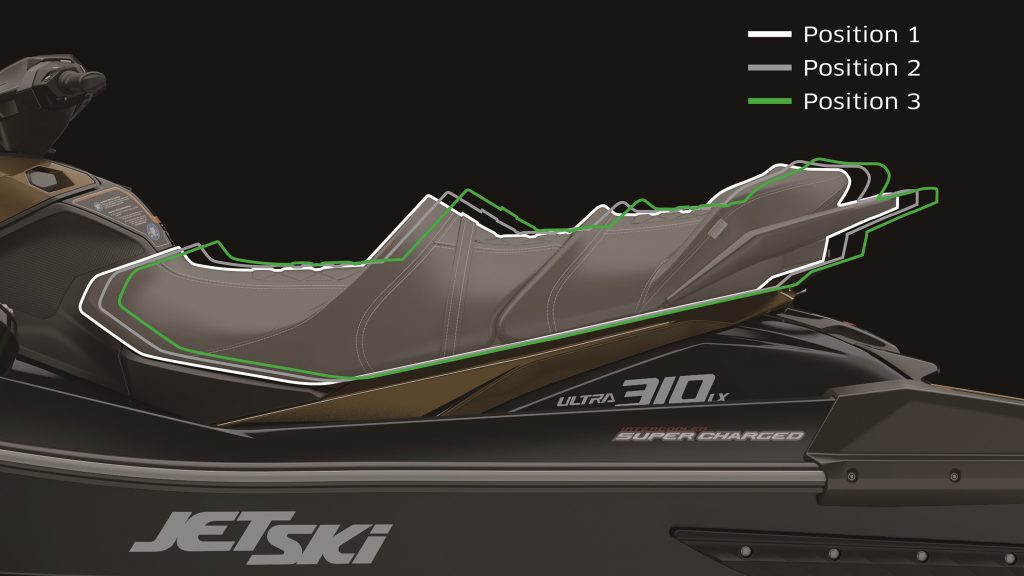
Another first, on the flagship 2022 Kawasaki Ultra 310LX the tiered seating can be positioned in one of three riding heights.
It’s unclear if the handlebars have been moved forward (one of the criticisms of the outgoing model is that the handlebars are too far rearward for riders who prefer to stand or crouch when in rough chop).
However, the handlebars have five steps of height adjustment, as before.


The first reviews of the 2022 Kawasaki Ultra 310 range aren’t due to commence in the US until later this year, in the lead-up to the northern hemisphere winter.
The world’s largest Jet Ski website, The Watercraft Journal, will likely to be first to conduct an independent test.
Here in Australia, Watercraft Zone will keep you posted when we get our first chance to test the 2022 Kawasaki Ultra 310 – and go through the changes in more detail.
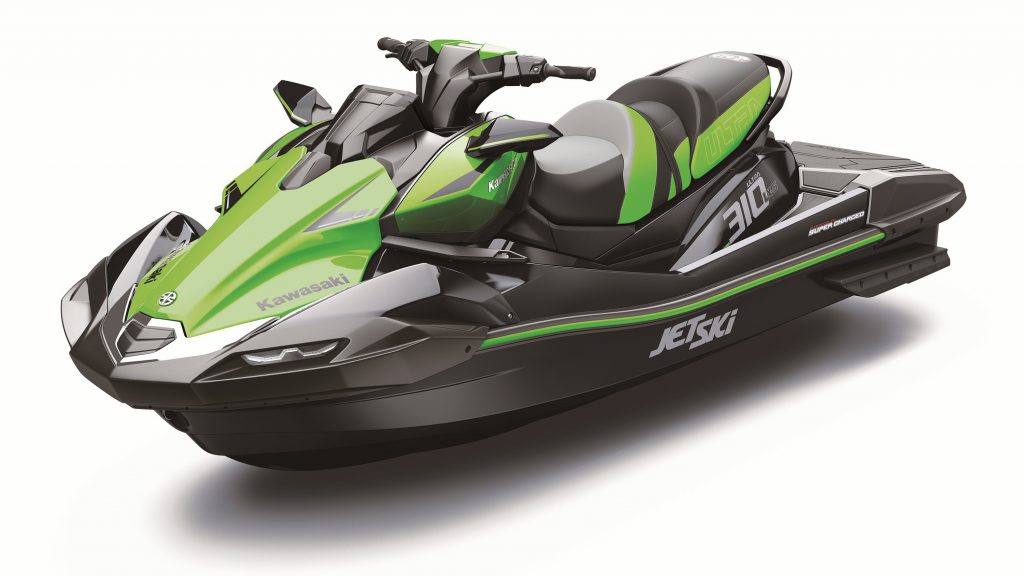
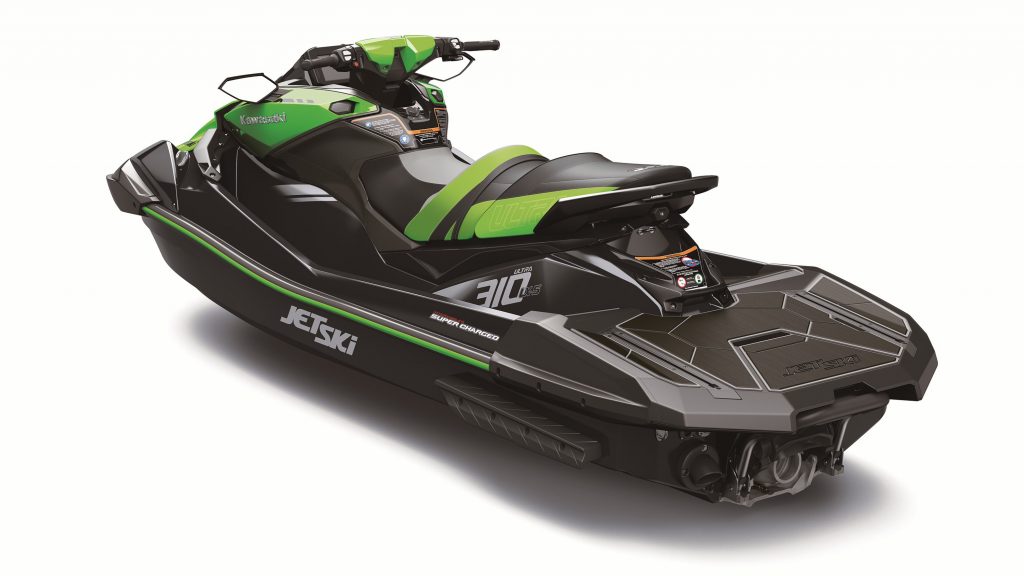
In the meantime, it seems the loyalty of Kawasaki fans is about to be rewarded after years of minimal updates beyond colour and trim changes.
While postponing the introduction of these upgrades to the non-supercharged Kawasaki Ultra until 2023 or beyond is seen as a missed opportunity in the booming Yamaha FX HO and Sea-Doo Fish Pro price points, there’s no doubt Kawasaki is well positioned to make up lost ground.
MORE: Follow us on Facebook
MORE: 2021 Kawasaki prices and model changes
MORE: 2022 Sea-Doo prices and model changes
MORE: 2022 Yamaha WaveRunner prices and model changes





